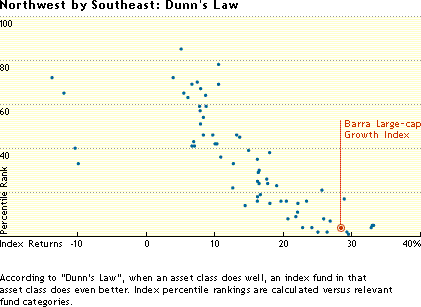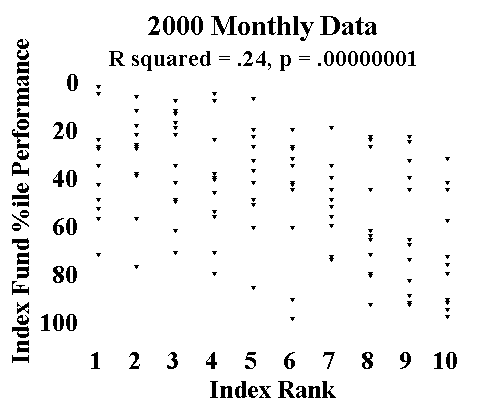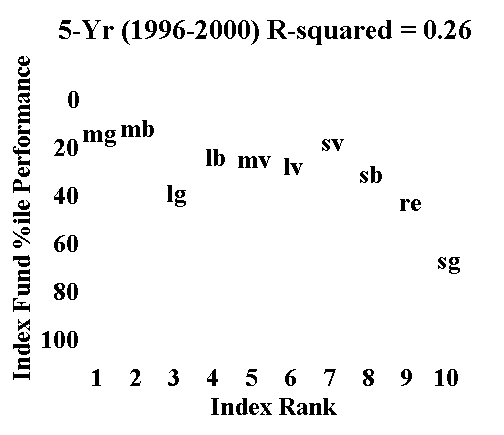Efficient Frontier

William J. Bernstein
Efficient Frontier

William J. Bernstein
![]()
Dunnís Law Review
The Life and Times of "Core and Explore"
When an asset class does well, an index fund in that asset class does even better.—Steven Dunn
One of the silliest bits of conventional financial wisdom is the notion that while indexing works well with the efficient U.S. large-cap market, there is benefit from active management in the "less efficient" small-cap and foreign arenas. In fact, Charles Schwab enshrined this dubious notion with its "Core and Explore" concept—index ("core") the former, and actively manage ("explore") the latter. This comforts greatly the legions of active-management-associated investment advisors and pension consultants, to whom it grants brief respite from the dustbin of financial history.
Obviously, the good folks at Schwab haven't yet heard the Gospel According to Dunn: that the fortunes of indexing a particular asset class depend on its performance relative to other asset classes. Iíve already covered this ground in a previous piece. John Rekenthaler also looked at the data from a somewhat different perspective (and, to my chagrin, came up with bigger t-stats than mine). For example, take a gander at the summary graph from his article:

Mr. Rekenthalerís graph is a bit confusing since his y-axis is conventionally plotted, meaning that the best index performances are at the bottom (the best performers have the lowest numbers:1st percentile is the top percentile, 100th the worst). But it is quite clear that there is a strong relationship between how well the asset class does and how well indexing it works. In fact, if you closely examine his plot youíll see that the relationship is curvilinear; there isnít much difference between indexing the best and the middling asset classes. Index performance only begins to suffer with the very worst asset classes.
I've looked at Dunn's Law (DL) both in the U.S. and abroad. Bottom line: DL works very well domestically but not abroad, because of Rekehthaler's "Purity Theory": It's easy for a money manager to stray from his or her style box domestically, but harder for a foreign manager to stray across national boundaries.
It's always nice to test one's hypotheses "out of sample" to guard against data mining: maybe results were just an accident of the time period studied. So I decided to look at DL prospectively, starting with a survivorship-bias-free sample of monthly data beginning January 2000, for the following asset classes and their respective indexes:
Asset Class
Abbreviation
Index Used
Available Fund
Large Cap Growth
lg
Barra LG
Vanguard Growth Index
Large Cap Blend
lb
S&P 500
Vanguard 500 Index
Large Cap Value
lv
Barra LV
Vanguard Value Index
Mid Cap Growth
mg
Barra MG
None
Mid Cap Blend
mb
S&P 400
Vanguard Mid Cap Index
Mid Cap Value
mv
Barra MV
None
Small Cap Growth
sg
Barra SG
Vanguard Small Cap Growth Index
Small Cap Blend
sb
S&P 600
None
Small Cap Value
sv
Barra SV
Vanguard Small Cap Value Index
REIT
re
DFA REIT
DFA Real Estate Securities
As in the previous study, I ranked from 1 (best) to 10 (worst) the performance of each index, and plotted it against the percentile performance for the index in each style box versus the active funds. Purists will chafe at the use of an index instead of an actual fund, but since funds were not available for all of the indexes, I wanted to be internally consistent. Further, of the six funds available from Vanguard, four have managed to equal or surpass their benchmarks by small amounts. This analysis produced 120 data points, plotted below:

This is a bit of a scattergram, but the "northwest to southeast" bias of the results is still fairly discernible. (Note that I've inverted the percentile scale on the y-axis, placing the "good results" at the top of the graph. This is the opposite of the convention used in Mr. Rekenthaler's graph.) The statistical power of the data, even after only 12 months, is staggering: a t-stat of 6.15 and a p value of 10-8. The individual monthly plots are fascinating. In some months, like January, March, August, and December, the points line up like the Rockettes, with highly statistically significant results. (In these four months, the t-stats were 4.00, 3.53, 4.44, and 6.53, respectively, with p values of .004, .008, .002, and .0002.) In other months, the relationship is nonexistent. I've posted the individual plots on a separate page. Those of you who would like the study data may contact me.
But the punchline is the relative ranking of the asset class groups. Below I've plotted the full-year graphs for 1997 and 2000:
As you can see, in 1997 indexing large caps (the lg, lb, and lv data points) worked better in general than indexing small caps (the sg and sb data points); this certainly did not occur in 2000 when small-cap stocks outperformed large. So good-bye "Core and Explore." In fact, to the extent that there's a small-cap premium, indexing small caps should actually work better than large caps. And, to add insult to injury, indexing foreign stocks in 2000 also rebounded: DFA's large-cap foreign and value portfolios ranked in the 37th and 6th percentiles of all foreign funds, respectively, and its long-suffering international small and small value strategies ranked at the 14th and 9th percentiles. To complete the picture, here's the plot for the past five years:

Finally, the phenomenon of "percentile compounding" shows up well in this sample: for the 120 monthly data points in 2000, the average index fund percentile rank was 46th. But over the whole year, the 10 asset classes averaged out to 40th. (So much for the bromide that "indexing didn't work in 2000.") And for the past five years, the average performance of the indexes was 30th percentile.
Out of habit, I'll probably continue this study another year, but given the stunning statistical significance of the above results, I'm probably just amusing myself. Oh yes, and send a memo to the folks at Schwab: Forget about exploring; stick to coring.
Copyright © 2001, William J. Bernstein